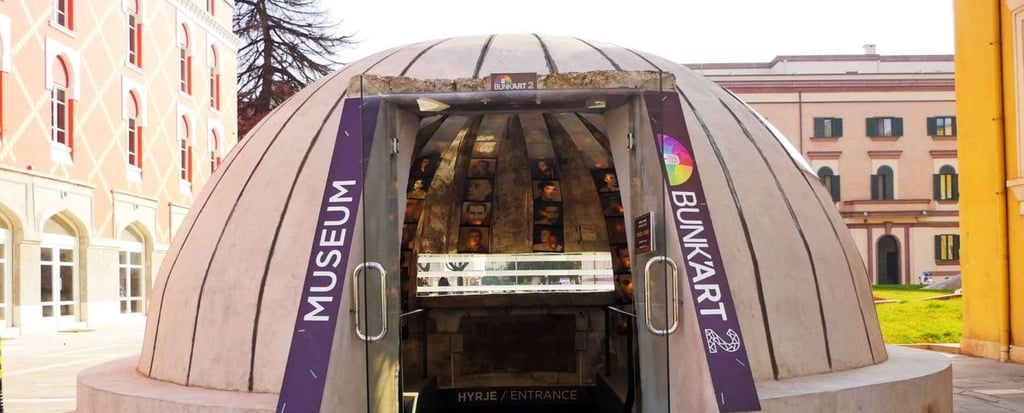Bunk'Art: Transforming Cold War Relics into Immersive Museums
Step into Albania’s Cold War time capsule—Bunk'Art: where totalitarian paranoia meets modern art, and concrete bunkers become must-see museums.


In the capital of Albania, beneath the hum of modern life and the bustle of Tirana’s urban revival, lie remnants of a paranoid past—enormous concrete bunkers that once stood as secret fortresses of fear. Today, these relics have been transformed into some of the most immersive and thought-provoking museums in the Balkans. Known collectively as Bunk’Art, these underground spaces tell the story of a country once sealed off from the world by dictatorship, paranoia, and iron-fisted control—and they do so through a stunning blend of historical exhibits and contemporary art.
A Nation Beneath the Surface
To understand Bunk’Art, one must first understand why these bunkers exist. Under the communist regime of Enver Hoxha, who ruled Albania from 1944 to 1985, the country became one of the most isolated and heavily militarized states in the world. Paranoid about foreign invasion—from NATO, the USSR, or both—Hoxha ordered the construction of hundreds of thousands of concrete bunkers across the Albanian landscape. These small dome-like structures became part of the country’s visual identity, littering fields, coastlines, and mountain slopes.
But far more secretive and terrifying were the elite underground bunkers built deep beneath the earth’s surface. These were not tiny hideouts for soldiers, but nuclear-proof sanctuaries intended to protect Albania’s leadership in the event of a global war. Forgotten for decades after the fall of communism, two of the most significant of these sites—one in the hills outside Tirana and another in the city center—were restored, reimagined, and opened to the public. They are now known as Bunk’Art 1 and Bunk’Art 2.
Bunk’Art 1: The Palace of Panic
Located near the Dajti Express cable car station on the edge of the city, Bunk’Art 1 is the larger of the two. It is not merely a museum—it is a subterranean labyrinth, a massive Cold War bunker with over 100 rooms spread across five underground levels.
The entrance is unassuming, almost hidden in a wooded slope. But as soon as the blast doors close behind you, a different world opens up: concrete hallways curve endlessly, lit by low, cold light. Inside, you find bedrooms preserved exactly as they were when the leadership last used them, complete with rotary phones, maps, and period furniture. There’s a cinema room with propaganda reels, military communication centers, decontamination chambers, and the former Council of Ministers’ meeting hall—a cavernous, dimly lit room where Albania’s elite would have coordinated the defense of the nation during a nuclear war.
But what makes Bunk’Art 1 extraordinary is not only the history it presents, but the artistic interpretation layered over it. In one hallway, the dull rhythm of dripping water echoes like a heartbeat, accompanied by recordings of state propaganda. In another room, a light installation flickers above a table set for officers who never returned. The fusion of historical documentation and conceptual art creates an eerie, immersive experience that moves beyond education and into emotion.
Visitors are not just reading history—they are walking through it. The claustrophobia, the secrecy, the dread—it all hangs thick in the air.
Bunk’Art 2: Surveillance and Silence
While Bunk’Art 1 reflects the fear of an external enemy, Bunk’Art 2, located just behind Skanderbeg Square in the center of Tirana, is about the enemy within. Built later, in the early 1980s, this smaller bunker housed the Ministry of Internal Affairs and the Sigurimi, the Albanian secret police.
As you descend the stairs into the bunker, you pass beneath a memorial dome covered in photographs of ordinary citizens who were surveilled, arrested, imprisoned, or killed during the communist era. The atmosphere shifts immediately: here, the emphasis is less military and more psychological.
You enter interrogation rooms lined with cold tiles. In one, you hear the recorded voices of survivors recounting how they were taken from their homes in the middle of the night. A narrow hallway leads to a re-creation of a prison cell. Another room displays the types of surveillance devices used to spy on neighbors, friends—even spouses. The audio guides explain how the state recruited informants and punished dissent with swift, often brutal force.
In a chilling juxtaposition, everyday objects are displayed alongside torture equipment—reminding visitors how closely the mundane and the monstrous coexisted.
Where Bunk’Art 1 is vast and theatrical, Bunk’Art 2 is intimate and chilling—a story of betrayal, silence, and fear that unfolded not in some imagined battlefield, but in living rooms, schools, and workplaces across Albania.
Politics of Memory
Both museums are part of a wider project to confront Albania’s difficult 20th-century legacy. For many years after the fall of communism in 1991, Albanians preferred to forget the past. The transition was painful: economic collapse, mass migration, and national trauma left little energy for historical reckoning. But in recent years, the country has begun to open up not just to the world, but to its own memory.
The conversion of these bunkers into museums is not just a clever use of space—it’s a symbolic act. Structures once built to protect a regime from its people now educate those very people—and international visitors—about the truth that regime tried so hard to suppress. It is an act of reclamation. The state’s instruments of control are now vessels of collective memory, dialogue, and even healing.
These museums are also part of a global movement often called “dark tourism”—where visitors seek to understand historical suffering by experiencing the places in which it occurred. Like Auschwitz in Poland, the Tuol Sleng Genocide Museum in Cambodia, or the KGB Museum in Vilnius, Bunk’Art invites visitors to engage not as passive spectators but as witnesses.
Since opening, both Bunk’Art sites have received praise from international press and visitors alike. Travel magazines have listed them among the “must-see” museums of Europe. Lonely Planet describes them as “deeply atmospheric and unmissable.” Reviewers on travel platforms like TripAdvisor routinely note how unexpectedly powerful the visits are—how what seems like a novelty at first becomes an emotionally gripping, often humbling experience.
It’s also becoming a symbol of Tirana’s changing identity. Once mocked as “the city of bunkers,” Tirana is now reclaiming that label as a source of introspection and even innovation. By embracing its past, Tirana has created a space that is intellectually rigorous, emotionally moving, and creatively inspired.
Practical Information
Bunk’Art 1 is located at the foot of Mount Dajti. You can take the Dajti Express cable car or a taxi from the city center. It is open Monday–Thursday from 9:30 am to 4:30 pm and Friday–Sunday from 9:30 am to 5:30 pm.
Bunk’Art 2 is located centrally on Abdi Toptani Street, behind the Ministry of Internal Affairs. Open Monday–Thursday from 9:30 am to 6:00 pm and Friday–Sunday from 9:30 am to 8:00 pm.
Tickets can be purchased at the entrance or online. An audio guide is highly recommended for international visitors.
For more information visit the official website: www.bunkart.al






